Related Research Articles

A Regierungsbezirk means "governmental district" and is a type of administrative division in Germany. Four of sixteen Bundesländer are split into Regierungsbezirke. Beneath these are rural and urban districts.

The Province of Silesia was a province of Prussia from 1815 to 1919. The Silesia region was part of the Prussian realm since 1740 and established as an official province in 1815, then became part of the German Empire in 1871. In 1919, as part of the Free State of Prussia within Weimar Germany, Silesia was divided into the provinces of Upper Silesia and Lower Silesia. Silesia was reunified briefly from 1 April 1938 to 27 January 1941 as a province of Nazi Germany before being divided back into Upper Silesia and Lower Silesia.
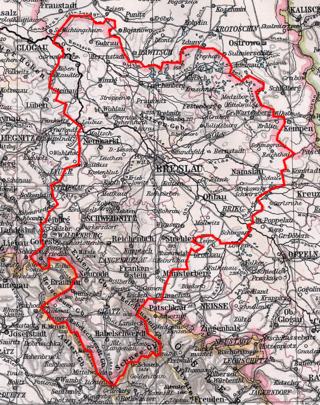
Regierungsbezirk Breslau, known colloquially as Middle Silesia was a Regierungsbezirk, or government region, in the Prussian Province of Silesia and later Lower Silesia from 1813 to 1945. It comprised the eastern parts of the historic Lower Silesia region and the former County of Kladsko, both of which were conquered by Prussia in the First Silesian War in 1742.
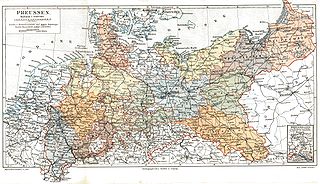
The Provinces of Prussia were the main administrative divisions of Prussia from 1815 to 1946. Prussia's province system was introduced in the Stein-Hardenberg Reforms in 1815, and were mostly organized from duchies and historical regions. Provinces were divided into several Regierungsbezirke, sub-divided into Kreise (districts), and then into Gemeinden (townships) at the lowest level. Provinces constituted the highest level of administration in the Kingdom of Prussia and Free State of Prussia until 1933, when Nazi Germany established de facto direct rule over provincial politics, and were formally abolished in 1946 following World War II. The Prussian provinces became the basis for many federal states of Germany, and the states of Brandenburg, Lower Saxony, and Schleswig-Holstein are direct successors of provinces.

The Province of Upper Silesia was a province of the Free State of Prussia from 1919 to 1945. It comprised much of the region of Upper Silesia and was eventually divided into two government regions (Regierungsbezirke) called Kattowitz (1939–1945), and Oppeln (1819–1945). The provincial capital was Oppeln (1919–1938) and Kattowitz (1941–1945), while other major towns included Beuthen, Gleiwitz, Hindenburg O.S., Neiße, Ratibor and Auschwitz, added in 1941. Between 1938 and 1941 it was reunited with Lower Silesia as the Province of Silesia.
Gęsiniec is a village in the administrative district of Gmina Strzelin, within Strzelin County, Lower Silesian Voivodeship, in south-western Poland. From 1867 to 1945, it was in Germany.

The Landkreis Freystadt i. Niederschles. was a district of the German state of Prussia from 1816 to 1945. It was part of the Prussian Province of Lower Silesia, before 1919 the Prussian Province of Silesia, within Regierungsbezirk Liegnitz. After 1945, it became part of Poland and is currently in the Lubusz Voivodeship. On 1 January 1945 it included:
Friedrich Wilhelm Leopold Konstantin Quirin Freiherr von Forcade de Biaix, aka Friedrich Wilhelm Leopold Konstantin Quirin von Forcade de Biaix, Herr of Schleibitz, Hamm, Groß-Naedlitz and Loslau, aka the Baron von Forcade,, Royal Prussian Major, Knight of the Iron Cross 2nd Class on 26 August 1813, knighted by His Majesty Frederick William III of Prussia as Knight of the Order of Saint John in 1817, Royal Prussian Chamberlain (Kammerherr) and Castellan (Drost) of Neuenrade in the County of Mark, after his father's death in 1808. He was also a publisher, author, and theater director.

Landkreis Namslau was a district in Prussian Silesia, from 1742 to 1945. The district capital was at Namslau. Today, the territory of the district is located in the Polish Opole Voivodeship.

Landkreis Kreuzburg O.S. was a Prussian district in Silesia, from 1742 to 1945, with its capital at Kreuzburg O.S. Today, the region is part of the Polish Opole Voivodeship.
Landkreis Leobschütz was a Prussian district in Silesia, from 1743 to 1945, with its capital at Leobschütz. Its historical roots lie in the Duchy of Leobschütz.

The Groß Wartenberg district, known until 1888 as the Wartenberg district, was a Prussian district in Silesia from 1742 to 1945. Its capital was the town of Groß Wartenberg, which was known until 1888 as Polnisch Wartenberg. The area of this district now lies within the Lower Silesian Voivodeship of Poland.
The District of Ohlau was a Prussian district in Silesia, which existed between 1742 and 1932 and then from 1933 to 1945. The district office was in the city of Ohlau. The territory of this district is now part of the Lower Silesian Voivodeship in Poland.

The Rybnik district was a Prussian district in Upper Silesia from 1818 to 1926. Its capital was the city of Rybnik. The territory of this district is now in the Silesian Voivodeship in Poland.
The district of Glatz was a Prussian district in Silesia, which existed from 1742 to 1945. Its capital was the town of Glatz. Its territory is now part of the Polish Lower Silesian Voivodeship.
The district of Rothenburg was a Prussian district which existed from 1816 to 1947. Today, the territory of the district is split between Germany and Poland by the Lusatian Neisse.
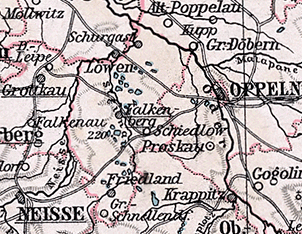
The Falkenberg O.S. district was a Prussian district in Upper Silesia, which existed from 1743 to 1945. Its capital was the town of Falkenberg O.S. The territory of this district is now located within the Opole Voivodeship of Poland.

The Neustadt O.S. district was a Prussian district in Upper Silesia from 1743 to 1945. Its capital was the city of Neustadt. Its territory corresponded roughly to the present-day Prudnik County in the Opole Voivodeship in Poland.
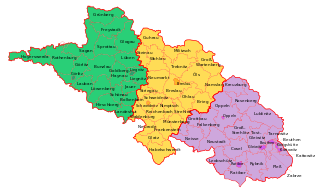
Regierungsbezirk Liegnitz was an administrative region in the Prussian Province of Silesia and later Lower Silesia. It existed from 1815 to 1945 and covered the north-western part of Silesia. The administrative region of Liegnitz became known colloquially as Lower Silesia.
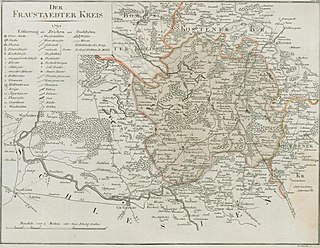
The Fraustadt district was Prussian district which existed in various borders from 1793 to 1945. From 1793 to 1807 it was located in the Province of South Prussia, from 1815 to 1848 in the Grand Duchy of Posen, from 1848 to 1920 in the Province of Posen, from 1922 to 1938, in the Province of Posen-West Prussia, from 1938 to 1941 in the Province of Silesia and from 1941 to 1945 in the Province of Lower Silesia.
References
- ↑ Gehrke, Roland (2009). Landtag und Öffentlichkeit: provinzialständischer Parlamentarismus in Schlesien 1825-1845 (in German). Böhlau Verlag Köln Weimar. ISBN 978-3-412-20413-6.
- ↑ Die Behördenorganisation und die allgemeine Staatsverwaltung Preussens im 18. Jahrhundert. University of California. Berlin, P. Parey. 1894.
{{cite book}}: CS1 maint: others (link) - ↑ "Landesbibliothekszentrum Rheinland-Pfalz / Amtsblatt für das Rhein-... [618]". www.dilibri.de. Retrieved 2021-01-01.
- ↑ Breslau (Regierungsbezirk) (1817). Amts-Blatt der Regierung in Breslau: 1817 (in German). Amtsblattstelle.
- ↑ Belzyt, Leszek (1998). Sprachliche Minderheiten im preussischen Staat: 1815 - 1914 ; die preußische Sprachenstatistik in Bearbeitung und Kommentar. Marburg: Herder-Inst. ISBN 978-3-87969-267-5.